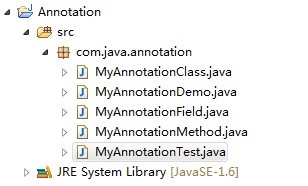首先什么是注解?
最常见的是,在我们使用Eclipse等工具编写java代码的时候,有时候会出现一些比如@Deprecated,@Override,@SuppressWarnings等东东。这个就是常见的几种注解。
在开发Java程序,尤其是Java EE应用的时候,总是免不了与各种配置文件打交道。以Java EE中典型的S(pring)S(truts)H(ibernate)架构来说,Spring、Struts和Hibernate这 三个框架都有自己的XML格式的配置文件。这些配置文件需要与Java源代码保存同步,否则的话就可能出现错误。而且这些错误有可能到了运行时刻才被发 现。把同一份信息保存在两个地方,总是个坏的主意。理想的情况是在一个地方维护这些信息就好了。其它部分所需的信息则通过自动的方式来生成。JDK 5中引入了源代码中的注解(annotation)这一机制。注解使得Java源代码中不但可以包含功能性的实现代码,还可以添加元数据。注解的功能类似 于代码中的注释,所不同的是注解不是提供代码功能的说明,而是实现程序功能的重要组成部分。Java注解已经在很多框架中得到了广泛的使用,用来简化程序 中的配置。
而我们最常见的可能就是上面提到的这三个注解了,简单的介绍一下上面的这三个注解的作用:
1、@Override:只能用在方法之上的,用来告诉别人这一个方法是改写父类的。
2、@Deprecated:建议别人不要使用旧的API的时候用的,编译的时候会用产生警告信息,可以设定在程序里的所有的元素上.
3、@SuppressWarnings:这一个类型可以来暂时把一些警告信息消息关闭.
在jdk自带的java.lang.annotation包里,打开如下几个源文件:
Target.java
Retention.java
RetentionPolicy.java
ElementType.java
@Documented
@Retention(RetentionPolicy.RUNTIME)
@Target(ElementType.ANNOTATION_TYPE)
public @interface Target {
ElementType[] value();
}
@Documented
@Retention(RetentionPolicy.RUNTIME)
@Target(ElementType.ANNOTATION_TYPE)
public @interface Retention {
RetentionPolicy value();
}
public enum RetentionPolicy {
SOURCE,
CLASS,
RUNTIME
}
public enum ElementType {
TYPE, FIELD, METHOD, PARAMETER, CONSTRUCTOR,
LOCAL_VARIABLE, ANNOTATION_TYPE,PACKAGE
}
在设计annotations的时候必须把一个类型定义为@interface。我们需要注意的是:SOURCE,CLASS 和 RUNTIME.这三个级别。
SOURCE代表的是这个Annotation类型的信息只会保留在程序源码里,源码如果经过了编译之后,Annotation的数据就会消失,并不会保留在编译好的.class文件里面。
ClASS的意思是这个Annotation类型的信息保留在程序源码里,同时也会保留在编译好的.class文件里面,在执行的时候,并不会把这一些 信息加载到虚拟机(JVM)中去.注意一下,当你没有设定一个Annotation类型的Retention值时,系统默认值是CLASS.
RUNTIME,表示在源码、编译好的.class文件中保留信息,在执行的时候会把这一些信息加载到JVM中去的.
@Target里面的ElementType是用来指定Annotation类型可以用在哪一些元素上的.说明一下:TYPE(类型), FIELD(属性), METHOD(方法), PARAMETER(参数), CONSTRUCTOR(构造函数),LOCAL_VARIABLE(局部变量), ANNOTATION_TYPE,PACKAGE(包),其中的TYPE(类型)是指可以用在Class,Interface,Enum和 Annotation类型上.
另外,@Target自己也用了自己来声明自己。如果一个Annotation类型没有指明@Target使用在哪些元素上,那么它可以使用在任何元素之上,这里的元素指的是上面的八种类型.
举几个正确的例子:
@Target(ElementType.METHOD) @Target(value=ElementType.METHOD) @Target(ElementType.METHOD,ElementType.CONSTRUCTOR)
@Documented的目的就是让这一个Annotation类型的信息能够显示在javaAPI说明文档上;没有添加的话,使用javadoc生成API文档的时候就会找不到这一个类型生成的信息.
另外一点,如果需要把Annotation的数据继承给子类,那么就会用到@Inherited这一个Annotation类型.
本文只是简单的说了一下注解的常规用法,至于更加深入的注解学习,请参见文章末尾的参考资料。下面我们来看自定义一个注解:源代码有如下几个:

源码分别为:
package com.java.annotation;
import java.lang.annotation.ElementType;
import java.lang.annotation.Retention;
import java.lang.annotation.RetentionPolicy;
import java.lang.annotation.Target;
/**
* 类注解
* */
@Retention(RetentionPolicy.RUNTIME)
@Target(ElementType.TYPE)
public @interface MyAnnotationClass {
public String msg();
}
package com.java.annotation;
import java.lang.annotation.ElementType;
import java.lang.annotation.Retention;
import java.lang.annotation.RetentionPolicy;
import java.lang.annotation.Target;
/**
* 方法注解
* */
@Retention(RetentionPolicy.RUNTIME)
@Target(ElementType.METHOD)
public @interface MyAnnotationMethod {
public String common();
}
package com.java.annotation;
import java.lang.annotation.ElementType;
import java.lang.annotation.Retention;
import java.lang.annotation.RetentionPolicy;
import java.lang.annotation.Target;
@Retention(RetentionPolicy.RUNTIME)
@Target(ElementType.FIELD)
public @interface MyAnnotationField {
boolean request();
}
package com.java.annotation;
@MyAnnotationClass(msg = "这个是一个类注解")
public class MyAnnotationDemo {
public MyAnnotationDemo() {
}
public MyAnnotationDemo(String hello) {
this.hello = hello;
}
@MyAnnotationMethod(common = "这个是一个方法注解")
public void method() {
System.out.println(hello);
}
@MyAnnotationField(request = true)
private String hello;
}
package com.java.annotation;
import java.lang.reflect.Field;
import java.lang.reflect.Method;
public class MyAnnotationTest {
public static void main(String[] args) {
MyAnnotationDemo demo = new MyAnnotationDemo("hello rollen");
MyAnnotationClass annotationClass = demo.getClass().getAnnotation(MyAnnotationClass.class);
System.out.println(annotationClass.msg());
Method method = null;
try {
method = demo.getClass().getMethod("method",new Class[0]);
} catch (SecurityException e) {
e.printStackTrace();
} catch (NoSuchMethodException e) {
e.printStackTrace();
}
MyAnnotationMethod annotationMethod = method.getAnnotation(MyAnnotationMethod.class);
System.out.println(annotationMethod.common());
Field field = null;
try {
field = demo.getClass().getDeclaredField("hello");
} catch (SecurityException e) {
e.printStackTrace();
} catch (NoSuchFieldException e) {
e.printStackTrace();
}
MyAnnotationField annotationField = field.getAnnotation(MyAnnotationField.class);
System.out.println(annotationField.request());
}
}